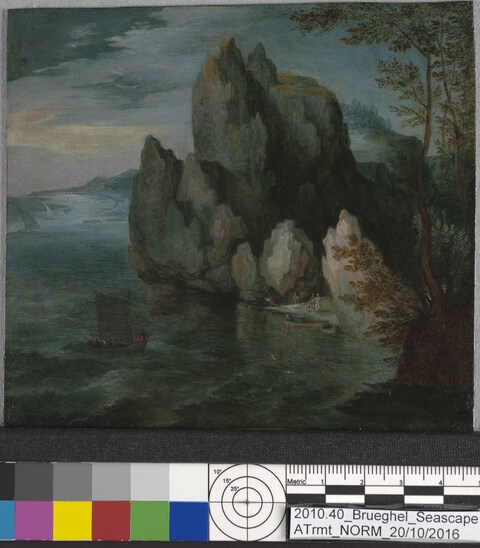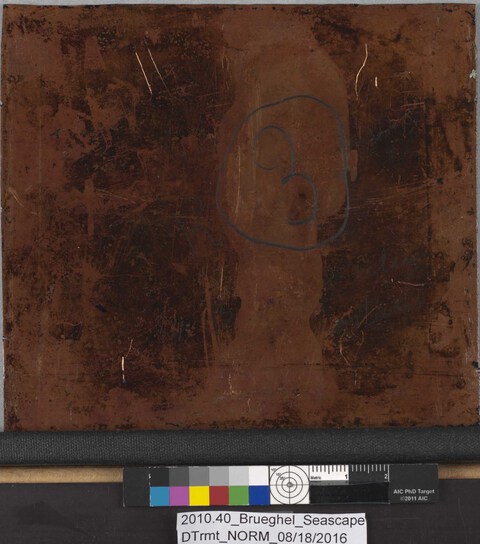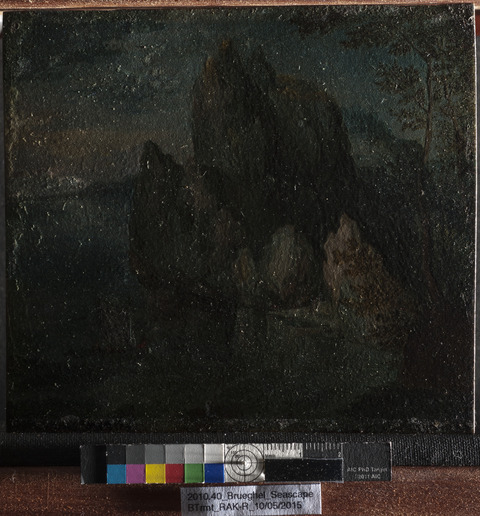Overview
Identification number: 2010.40
Artist: Jan Brueghel the Elder
Title: Seascape with a High Cliff
Materials: Oil (untested) on copper
Date of creation: About 15911
Previous number/accession number: C10014
Dimensions:
11.9 × 12.4 cm
Conservator/examiner: Fiona Beckett with contributions from Roxane Sperber
Examination completed: 2016, revised 2021
Distinguishing Marks
Front:
None
Back:
Item 1. Writing in pencil, back, center: “3,” circled (tech. fig. 1).
Item 2. Handwriting in pencil, back, bottom right, illegible (appears to be two words) (tech. fig. 1).
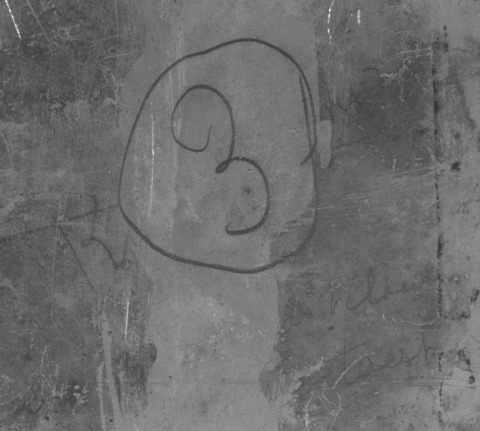
Summary of Treatment History
Documentation suggests a series of condition assessments and treatments were carried out on the collection around the time the works were moved from the Clowes' residence to the IMA in 1971. A condition report by Paul Spheeris in October of that year, likely carried out before the paintings were relocated, described the painting as “O.K.” He recommended cleaning for the sake of the work’s aesthetic appearance.2 A second condition assessment was carried out upon arrival of the paintings at the IMA. This assessment describes the work as being in good condition, and no work was deemed necessary.3
The painting was treated at the IMA in 2016 by Clowes Conservator of Paintings Fiona Beckett. During this treatment, the discolored varnish, overpaint, and old fill material was removed, and a new Paraloid B-72 varnish was applied. Corrosion was removed from the back of the copper plate, and a layer of Paraloid B-72 was applied to assist with preventing further corrosion. Losses to the painting were filled and inpainted. During the 2016 treatment, it was observed that the painting had undergone previous treatment campaigns prior to arriving at the IMA. These campaigns, while undocumented, included varnish removal, varnish application, fills, and retouching.
The painting was inspected in the Clowes Collection annual survey from 2011 to 2019.
Current Condition Summary
The painting is in excellent condition following the 2016 treatment. Structurally, the painting is stable with no major deformations in the support (the copper plate is slightly convex due to manufacturing, not damage) and good adhesion between the paint layers and the support. Aesthetically, the paint layer is almost in pristine condition with cracks only visible under the microscope. The varnish appears clear, and the inpainting is well matched.
Methods of Examination, Imaging, and Analysis
| Examination/Imaging | Analysis (no sample required) | Analysis (sample required) |
|---|---|---|
Unaided eye | Dendrochronology | Microchemical analysis |
Optical microscopy | Wood identification | Fiber ID |
Incident light | Microchemical analysis | Cross-section sampling |
Raking light | Thread count analysis | Dispersed pigment sample |
Reflected/specular light | X-ray fluorescence spectroscopy (XRF) | Fourier-transform infrared spectroscopy (FTIR) |
Transmitted light | Macro X-ray fluorescence scanning (MA-XRF) | Raman microspectroscopy |
Ultraviolet-induced visible fluorescence (UV) | ||
Infrared reflectography (IRR) | Gas chromatography–mass spectrometry (GC-MS) | |
Infrared transmittography (IRT) | Scanning electron microscope -energy dispersive X-ray spectroscopy (SEM-EDS) | |
Infrared luminescence | Other: | |
X-radiography |
Technical Examination
Description of Support
Analyzed Observed
Material (fabric, wood, metal, dendrochronology results, fiber ID information, etc.):
The painting is executed on a single copper plate.
Characteristics of Construction / Fabrication (cusping, beveled edges of panels, seams, joins, battens):
The copper plate is relatively even and flat with a slight curvature at the corners and a very slight overall convexity. It appears that the front of the plate was prepared prior to painting by roughening the surface beneath the paint layer. Small scratches are visible in a loss (tech. fig. 2).4 The back of the copper plate does not exhibit any clear hammering marks, though this most certainly was how the plate was produced.5 No makers stamp is present.6 The plate appears to have been cut from a larger piece of copper, and the edges and corners were then rounded and smoothed. The edges are not entirely straight and vary slightly.
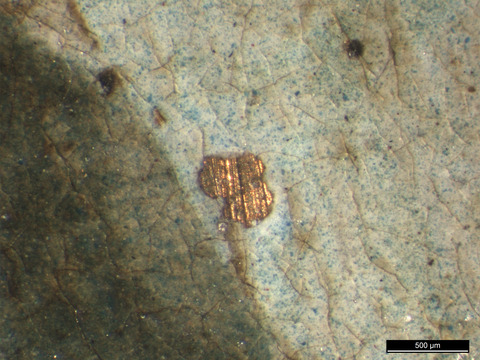
Thickness (for panels or boards):
The copper plate is approximately 0.9–1 mm thick.
Production/Dealer’s marks:
None
Auxiliary Support:
Original Not original Not able to discern None
Condition of Support
The copper plate is in good condition and remains stable. The edges of the metal support have sustained only minor damages where the copper plate has been bumped against a harder surface. This is mostly visible under the microscope.
During the 2016 treatment, unsightly black adhesive residues around the perimeter of the back were removed. These residues appear to have been applied during a previous framing where the plate was taped into place. Corrosion (tech. fig. 3) was found under the residues and was removed mechanically with a dental pick and a swab of acetone. A layer of Paraloid B-72 was then applied to the back to assist in protecting the copper from environmental moisture and to prevent further corrosion.
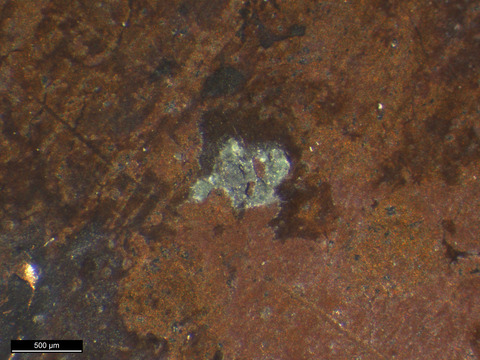
Description of Ground
Analyzed Observed
A thin layer of light-colored paint is visible under some areas of the composition. It does not, however, appear to be present over the entire surface. For example, along the right side there does not appear to be a ground layer under the browns of the tree, but in other areas a thin white layer is visible (tech. fig. 4). This may have been a deliberate choice to allow the color of the copper plate to enhance the tonal values in these areas. It is likely that a light ground layer was applied under much of the blue tones before painting.
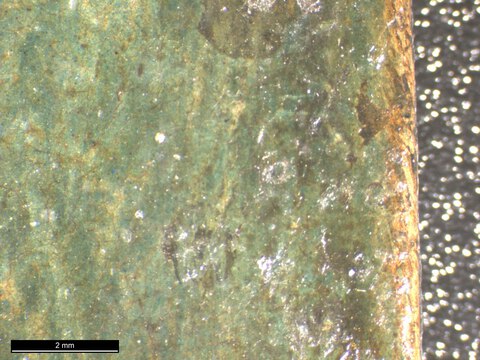
XRF revealed the presence of lead throughout the painting. It is likly that a very thin lead white ground is present over the surface of the copper plate, as would have been common practice. Calcium was also detected in all of the XRF spectra (table 1). This may suggest a mixture of calcium and lead in the ground layer. The degree to which chalk was added to lead white grounds to increase the transparency is not entirely understood. However, this occurrence has been noted in other works on copper.7
Materials/Binding Medium:
The binding media of the ground was not analyzed, although documentary evidence suggests that oil was traditionally used for the binder of grounds on copper panels.8 Additionally, one of the preparatory techniques for paintings on copper includes rubbing the copper with garlic to provide tooth and improve workability of the paint.9
Color:
Where present, the ground is a light off-white color.
Application:
One of Brueghel’s techniques was to apply the ground layer with his fingers, since this would eliminate any streaks and create an even smoother surface on which to work.10 Neither brushwork nor fingerprints can be distinguished through the texture of the overlying paint.
Thickness:
The ground layer is very thin, as is typical of Brueghel paintings, where the average paint and ground layer combined is 10 microns.11
Sizing:
In addition to rubbing of the copper plate with a garlic clove,12 it was common practice to prepare copper plates with a layer of linseed oil, which would reduce the chance of the copper oxidizing and would allow the painting to remain in excellent condition and well adhered to the support. It has not been determined whether such a layer of oil is present on this painting.
Character and Appearance (Does texture of support remain detectable / prominent?):
The surface appears smooth and even. The roughening of the copper plate and the application of preparatory layers is not visible through the paint layers.
Condition of Ground
The pale underlayer, where visible, appears to be well adhered to the copper plate and to the paint layers. A fine network of micro cracks, nearly invisible to the unaided eye, can be seen under magnification, and these extend through the paint layer into the ground. The micro-cracking network is related to the aging process of the paint film, which remains in stable condition.
Description of Composition Planning
Methods of Analysis:
Surface observation (unaided or with magnification)
Infrared reflectography (IRR)
X-radiography
Analysis Parameters:
| IRR equipment and wavelength | Opus Instruments Osiris A1 infrared camera with InGaAs array detector operating at a wavelength of 0.9-1.7µm. |
|---|
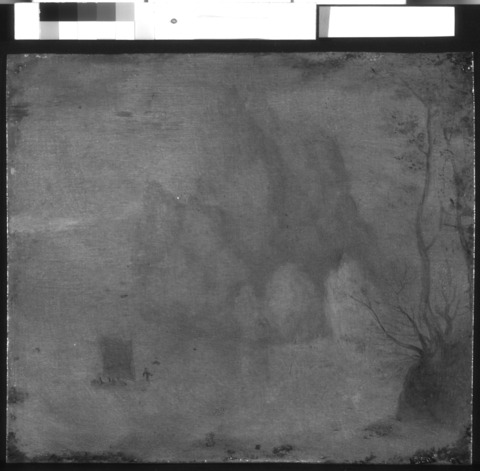
Medium/Technique:
No evidence of carbon-based underdrawing or underpainting was observed when the painting was imaged with infrared reflectography (tech. fig. 5). Along the right edge, the trees and branches appear more defined than the rest of the painting; however, this is most likely related to the increased presence of carbon in the black paint in these areas than from underdrawing, since the trees and branches are clearly painted over the underlying blue-green background.
Pentimenti:
No pentimenti were observed in the composition. The paint layers likely became slightly more translucent as the painting aged, thus showing more of the background than originally intended. For example, the figures on the seashore appear somewhat translucent, revealing the cliff and the shore through them.
Description of Paint:
Analyzed Observed
Application and Technique:
The paint appears to have been applied in layers with some areas being characteristic of wet-in-wet application, while others (such as the leaves of the tree) were applied wet-over-dry. The pigments appear very well ground and mixed with the binding medium. Several glazes were applied in layers to build up the blue-green shadows of the water and the cliffs (tech. fig. 6). The copper plate has not been deliberately left to show through the paint layers, although hints of copper are present in small areas, primarily along the edges. The water and sky were painted with a series of horizontal brushstrokes, while the cliffs and trees are painted with primarily vertical brushstrokes.
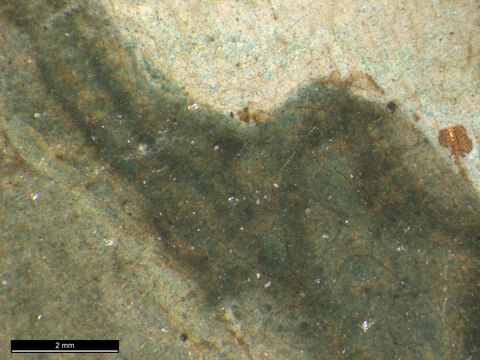
Painting Tools:
The paint was applied with brushes varying in size. Smaller brushes were employed for details such as the leaves.
Binding Media:
Investigation of media used in copper panel paintings from the sixteenth to the eighteenth centuries has been limited. However, analysis carried out so far suggests that linseed oil was the primary medium used.13 The binding media of this painting were not confirmed during this investigation, though the brushwork in the painting is suggestive of an oil medium.
Color Palette:
The color palette is comprised of a general greenish-blue tone with some grays, and a reddish-brown employed for the landscape. Ochers are used in the highlights of the sky and in the undertones of the cliffs. The colors appear slightly muted in some areas due to discoloration of the varnish and incomplete saturation of the paint layer. Finely ground blue particles (likely azurite) can be seen when the painting is viewed with a microscope.
XRF analysis indicates the presence of lead and calcium throughout the painting, possibly related to a ground layer. Copper is present in all samples and is related to the support as well as copper-containing pigments such as azurite and malachite. Barium and chromium were found in the buttery-yellow color at the central cliff peak, as well as in the tree along the right edge. This is most likely retouching with barium chromate yellow (also known as lemon yellow), which was available in 1807. Mercury was found in the red fisherman figure, indicating that vermilion was used in this area.
XRF analysis:
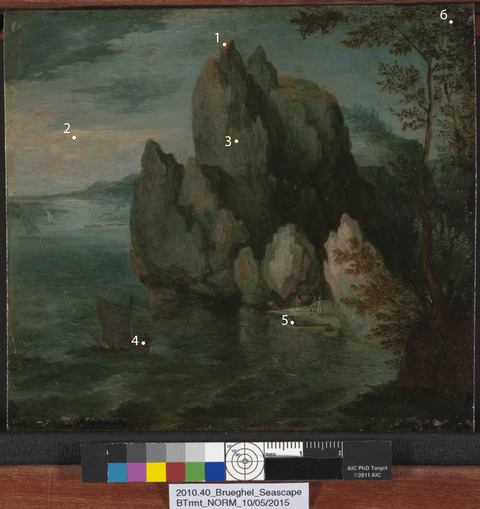
| Sample | Location | Elements | Possible Pigments |
|---|---|---|---|
| 1 | Yellow retouching at central mountain peak | Major: Cu, Pb, Fe Minor: Ca, Cr Trace: Ba, Si, K, Zn, Mn | Copper from support and/or azurite pigment, lead white, iron oxide (earth pigments), calcium (possibly from ground layer), barium chromate yellow (lemon yellow retouching). |
| 2 | Yellow in Sky | Major: Pb, Cu Minor: Ca, Fe Trace: Si | Lead white, copper from support and/or azurite, calcium (possibly from ground layer), iron oxide (earth pigments). |
| 3 | Yellow at central mountain peak | Major: Cu, Pb, Fe Minor: Ca Trace: Ti, Si | Copper from support and/or azurite pigment, lead white, iron oxide (earth pigments), calcium (possibly from ground layer). |
| 4 | Red fisherman | Major: Cu, Pb, Hg Minor: Ca, Fe Trace: | Copper from support and/or azurite, lead white, vermilion, calcium (possibly from ground layer), iron oxide (earth pigments). |
| 5 | Blue fisherman | Major: Cu, Pb Minor: Ca, Fe Trace: Si, K, | Copper from support and/or azurite, lead white, calcium (possibly from ground layer), iron oxide (earth pigments). |
| 6 | Green tree | Major: Cu, Pb Minor: Ca, Fe Trace: Cr, Ba, K, Si | Copper from support and/or copper-containing green and/or blue pigment, lead white, calcium (possibly from ground layer), iron oxide (earth pigments), barium chromate yellow (lemon-yellow retouching). |
Table 1: Results of X-ray fluorescence analysis conducted with a Bruker Artax microfocus XRF with rhodium tube, silicon-drift detector, and polycapillary focusing lens (~100μm spot).
*Major, minor, trace quantities are based on XRF signal strength not quantitative analysis
Surface Appearance:
The build up of paint layers cause a relief effect on the painting’s surface. The relief effect is readily visible in specular light. (tech. fig. 8).
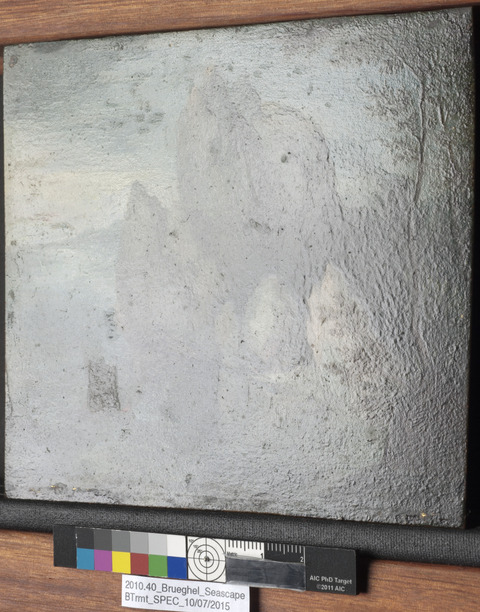
Condition of Paint:
The paint is in good condition overall with no discernible damages since the 2016 conservation campaign. Minor older losses to the original paint layer around the perimeter and in the upper-right corner were observed during the 2016 campaign and were inpainted.
Description of Varnish/Surface Coating
Analyzed Observed Documented
| Type of Varnish | Application |
|---|---|
Natural resin | Spray applied |
Synthetic resin/other | Brush applied |
Multiple Layers observed | Undetermined |
No coating detected |
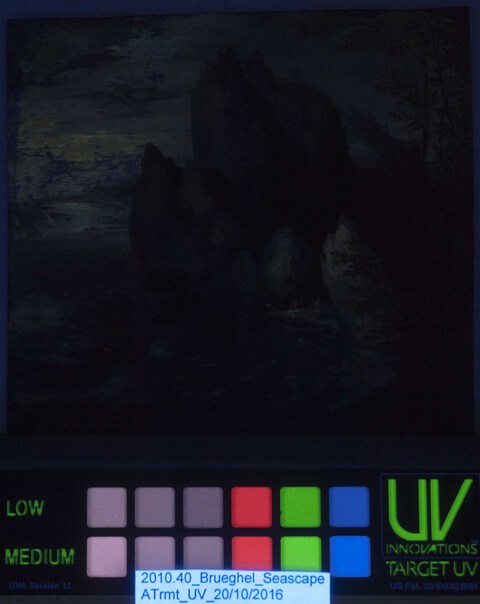
A synthetic coating of Paraloid B-72 was applied in 2016. This layer does not fluoresce under ultraviolet-induced visible fluorescence (tech. fig. 9). Inpainting is present on the painting and was accomplished with AYAA/AYAC (2:1) in 1-methoxy-2-propanol and conservation-grade dry pigments, also during the 2016 treatment.
Condition of Varnish/Surface Coating
The varnish and inpainting are in excellent condition.
Description of Frame
Original/first frame
Period frame
Authenticity cannot be determined at this time/ further art historical research necessary
Reproduction frame (fabricated in the style of)
Replica frame (copy of an existing period frame)
Modern frame
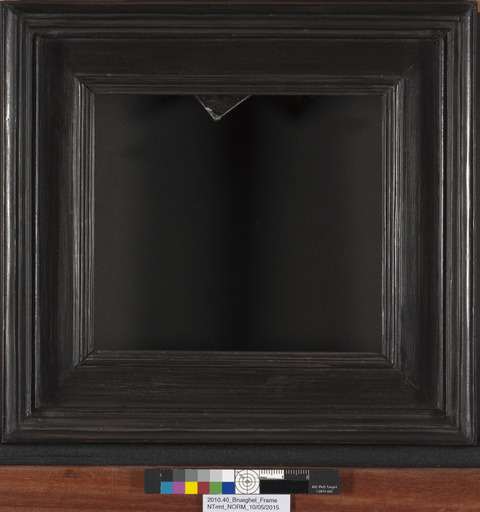

Frame Dimensions:
Outside frame dimensions: 18.5 × 19.8 × 3 cm
Distinguishing Marks:
None
Description of Molding/Profile:
The frame appears to be a modern replica in the style of a Dutch period frame (tech. fig. 10). It has a dark brown stain and mitered corners (tech. fig. 11).
Condition of Frame
The frame is structurally secure and in good aesthetic condition.
Notes
-
Ian Fraser indicated a date of about 1590–1600 in the 1973 edition of the Clowes catalogue, while IMA records identify the date as “about 1591.” A. Ian Fraser, A Catalogue of the Clowes Collection (Indianapolis: Indianapolis Museum of Art, 1973), 120. ↩︎
-
Paul A.J. Spheeris, “Conservation Report on the Condition of the Clowes Collection,” 25 October 1971, Conservation Department Files, Indianapolis Museum of Art at Newfields. ↩︎
-
Martin Radecki, Clowes Collection condition assessment, undated (after October 1971), Conservation Department Files, Indianapolis Museum of Art at Newfields. ↩︎
-
Isabelle Horovitz, “The Materials and Techniques of European Paintings on Copper Supports,” in Copper as Canvas: Two Centuries of Masterpiece Paintings on Copper 1575–1775, ed. Michael Komanecky (Phoenix: Oxford University Press in association with Phoenix Art Museum, 1998), 67–68. ↩︎
-
Most copper supports for painting were produced by hammering until the late eighteenth century. See Isabel Horovitz, “Paintings on Copper: A Brief Overview of Their Conception, Creation and Construction” in Paintings on Copper and Other Metal Plates: Production, Degradation and Conservation Issues, ed. Laura Fuster López et al. (València: Universitat Politécnica de València, 2017), 19. ↩︎
-
Intriguingly, makers' stamps on copper plates from Antwerp, where Brueghel lived for much of his life, are not found as frequently as marks on wooden panels from this region. Jørgen Wadum, “The Spanish Connection: The Making and Trade of Antwerp Paintings on Copper in the Seventeenth Century” in Paintings on Copper and Other Metal Plates: Production, Degradation and Conservation Issues, ed. Laura Fuster López et al. (València: Universitat Politécnica de València, 2017), 33. ↩︎
-
Isabelle Horovitz, “The Materials and Techniques of European Paintings on Copper Supports,” in Copper as Canvas: Two Centuries of Masterpiece Paintings on Copper 1575–1775, ed. Michael Komanecky (Phoenix: Oxford University Press in association with Phoenix Art Museum, 1998), 73. ↩︎
-
Isabel Horovitz “Paintings on Copper: A Brief Overview of Their Conception, Creation and Construction” in Paintings on Copper and other Metal Plates: Production, Degradation and Conservation Issues ed. Laura Fuster López et al. (València: Universitat Politécnica de València, 2017), 20. ↩︎
-
Isabelle Horovitz, “The Materials and Techniques of European Paintings on Copper Supports,” in Copper as Canvas: Two Centuries of Masterpiece Paintings on Copper 1575–1775, ed. Michael Komanecky (Phoenix: Oxford University Press in association with Phoenix Art Museum, 1998), 70. ↩︎
-
Michael Komanecky, “Jan Breughel I” catalogue entry in Copper as Canvas: Two Centuries of Masterpiece Paintings on Copper 1575–1775, ed. Michael Komanecky (Phoenix: Oxford University Press in association with Phoenix Art Museum, 1998), 150–154. ↩︎
-
Isabelle Horovitz, “The Materials and Techniques of European Paintings on Copper Supports,” in Copper as Canvas: Two Centuries of Masterpiece Paintings on Copper 1575–1775, ed. Michael Komanecky (Phoenix: Oxford University Press in association with Phoenix Art Museum, 1998), 76. ↩︎
-
Isabelle Horovitz, “The Materials and Techniques of European Paintings on Copper Supports,” in Copper as Canvas: Two Centuries of Masterpiece Paintings on Copper 1575–1775, ed. Michael Komanecky (Phoenix: Oxford University Press in association with Phoenix Art Museum, 1998), 70. ↩︎
-
Isabelle Horovitz, “The Materials and Techniques of European Paintings on Copper Supports,” in Copper as Canvas: Two Centuries of Masterpiece Paintings on Copper 1575–1775, ed. Michael Komanecky (Phoenix: Oxford University Press in association with Phoenix Art Museum, 1998), 73. ↩︎
Additional Images
